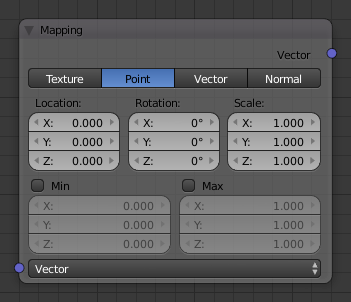Mapping Node¶
The Mapping Node is used to transform an image or procedural texture. For example, you can use it to move, rotate, or scale textures. If you have ever done any UV editing in the past, then you will likely know that these can also be accomplished by modifying an object's UVs in the UV editor. However, it is sometimes useful to have easy access to these functions through nodes rather than having to modify the UVs. One example of this might be when you have several textures, each of which needs to be transformed individually e.g. decals on an object.

Mapping node.
Inputs¶
- Vector
- Vector to be transformed, usually this is input from a Texture Coordinate node.
Properties¶
- Vector type
Allows the user to choose which vector type to use.
- Texture
- This is the most common option that you will use and will be sufficient for most cases.
- Point
- This works similar to Texture but the way the math works the Scale values are divided rather than multiplied.
- Vector
- Behaves the same as Point mode but changes in Location are ignored -- that is, the texture does not move.
- Normal
- Transforms a normal vector with unit length.
- Location
- Vector translation.
- Rotation
- Rotation of the vector along the XYZ axes.
- Scale
- Scale of the vector, in Point and Vector modes, a value of 2.0 will halve the texture size, while in Texture mode the size is double.
- Min/Max
- Normalizes the Location, Rotation, and Scale values to fit within the specified XYZ values.
Outputs¶
- Vector
- Transformed vector, usually gets connected to some sort of Texture node.
Examples¶
Todo <2.8 add.